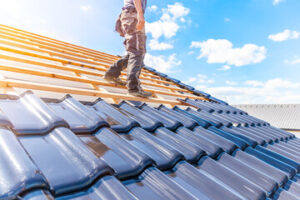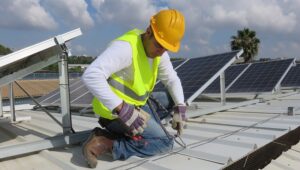A well-maintained roof can withstand a lot of wear and tear. However, if your roof is damaged, it’s important to get repairs as soon as possible.

To avoid costly mistakes, make sure you’re working with a professional. Here are some early warning signs that your roof may need repair. Visit https://www.bostonroofingco.com/ to learn more.
The purpose of roof flashing is to prevent leaks around chimneys, vents, skylights, and other roof penetrations. Typically made of metals that are resistant to corrosion, flashing is placed at points of leak prone areas, and serves to direct water away from those areas and into gutters or off the roof. Damaged or faulty flashing can allow moisture to seep into these vulnerable spots, causing serious damage and creating expensive repair bills for homeowners.
If you suspect that your flashing is damaged, it’s important to have it checked out by a professional. There are many causes of roof flashing damage, such as rust or corrosion, physical damage (such as a fallen tree limb that pierces the soft metal) or poor installation. Flashing may also become damaged due to weather conditions, such as harsh rain or high winds that can crack or rip flashing off the roof.
Damaged flashing can leave these vulnerable roof areas exposed to water infiltration and the potential for wood rot or mold. Common signs of flashing damage include visible rust or corrosion, discoloration on the ceiling or walls that indicates moisture has penetrated the roof, and leaks during rainfall.
Flashing is a complex part of the roofing system and should only be repaired by an experienced roofer. It’s not recommended that homeowners attempt to fix roof flashing on their own, as it can be a difficult and time-consuming process. In addition, it’s possible to make mistakes during the repair process that can result in leaks or further damage.
A professional roofer will have the tools and experience necessary to quickly and efficiently fix roof flashing problems, preventing leaks and costly repairs. For those interested in repairing their own roof flashing, it’s helpful to have some basic tools on hand, including:
Damaged Built-Up Roofing (BUR)
While built-up roofing is a durable option, it can also experience damage over time. If you notice your BUR is damaged, it’s important to act quickly to repair the damage. This is because if left unchecked, it can lead to serious leaks and other problems.
The good news is that the repair process is relatively simple. Once you’ve cleaned and dried the area, you can then apply a layer of roofing cement to the affected spot. Next, you’ll need to apply a layer of roof felt over the cement. This will help to prevent further damage to your roof.
One of the most common types of damage to built-up roofing is cracking. If you notice cracking, it’s important to hire a professional as soon as possible to repair the damage. This is because cracking can lead to water leaks and other problems, and if left unchecked, it may cause the BUR to deteriorate faster than normal.
Another problem that you should keep an eye out for is erosion. This can happen when water gets under the BUR and starts to eat away at the layers. This can result in a weakening of the roof’s integrity, which could lead to damage to the structure and interior of the building.
A BUR industrial and commercial roof system is a great choice for many building types. It’s a time-tested and dependable system that has been in use for more than a century. It’s also energy efficient, especially if you choose to incorporate an insulation layer into the system.
A BUR roofing system is typically made from alternating layers of bitumen (typically asphalt, but sometimes coal tar) and felt sheets. The felts are typically fiberglass, although organic mats have been used historically. Usually, four plies of felt are recommended for asphalt BUR systems. The top layer is a cap sheet that can be surfaced with aggregate or field-applied coatings, as well as mineral surface caps. It’s recommended that you consult a contractor to determine which type of cap sheet is right for your roof.
Damaged Shingles
A roof’s shingles are what keep it protected against the elements and offer insulation for your home. Therefore, any damage to your shingles should be repaired immediately to prevent water from seeping into your home and causing further problems. If a single shingle is damaged, a roof repair professional can repair it in a number of ways, depending on the severity of the damage and the type of shingle.
Shingles can be resealed or glued to fix small cracks and chips. However, these solutions will only provide a temporary fix and should be used only in case of minor damage. The best way to repair a broken shingle is to replace it with a new shingle. This will ensure that the damaged shingle is replaced with one that will be equally durable and visually appealing.
It is important to regularly inspect your shingles for signs of damage. These include granule piles on the ground near your downspouts (these are the tiny stones that make up the asphalt shingles and protect against UV rays), buckling or curling of shingles, and water stains or dampness inside your home. If you suspect a problem with your shingles, you should call in a roofing contractor to conduct a detailed inspection and recommend the right roof repair for you.
A common cause of shingle damage is from hail. Hail often damages shingles by destroying the granule layer, leaving the shingle exposed to heat and sun damage. If you notice a shingle has been damaged by hail, it should be replaced as soon as possible.
Another common reason for shingle damage is improper ventilation. If you notice your shingles are getting warped and yellowed, you may need to install better roof vents to create more airflow and reduce the amount of heat on your shingle.
It’s also a good idea to regularly examine your fascia board, which runs along the edge of your roof and connects it to the rafters. The fascia board can be a vulnerable spot for damage, such as rotting wood or rusted metal. If the fascia board is in disrepair, it should be replaced to prevent further damage to your shingles and the integrity of your entire roof.
Damaged Gutters
Gutters play a crucial role in your roof’s defense system by collecting and routing rainwater away from the home. They’re responsible for keeping water from pooling under your shingles and causing serious structural damage. However, like any other part of the house, gutters can become damaged over time.
The main problem with gutters is that they can get clogged with leaves, twigs, and standing water. Clogged gutters lead to overflowing water, which can cause roof leaks, rot, and even mold. This water can also flow down the side of your house, exposing your foundation to excessive moisture. This can lead to cracks in the foundation, which is expensive to repair.
Another common problem is that gutters can become overloaded with debris, leading to them sagging or pulling away from the house. This can be caused by a combination of things, including the fact that debris build-up may have made the gutters too heavy for their fasteners. If this is the case, you might need to refasten the fasteners or replace the gutters altogether.
Additionally, clogged gutters can lead to ice dams in the winter. These ice dams can cause water to seep under the shingles, which can also damage them. Gutter guards or heating cables can be installed to prevent ice dams from forming and to keep gutters from overflowing when they melt.






